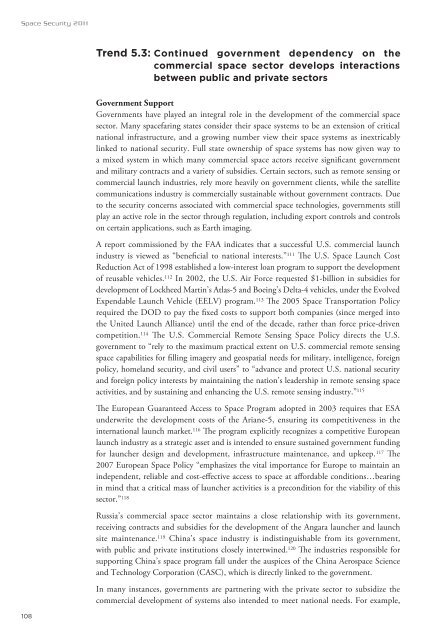Space Security Index
Space Security Index
Space Security Index
You also want an ePaper? Increase the reach of your titles
YUMPU automatically turns print PDFs into web optimized ePapers that Google loves.
<strong>Space</strong> <strong>Security</strong> 2011<br />
108<br />
Trend 5.3: Continued government dependency on the<br />
commercial space sector develops interactions<br />
between public and private sectors<br />
Government Support<br />
Governments have played an integral role in the development of the commercial space<br />
sector. Many spacefaring states consider their space systems to be an extension of critical<br />
national infrastructure, and a growing number view their space systems as inextricably<br />
linked to national security. Full state ownership of space systems has now given way to<br />
a mixed system in which many commercial space actors receive signicant government<br />
and military contracts and a variety of subsidies. Certain sectors, such as remote sensing or<br />
commercial launch industries, rely more heavily on government clients, while the satellite<br />
communications industry is commercially sustainable without government contracts. Due<br />
to the security concerns associated with commercial space technologies, governments still<br />
play an active role in the sector through regulation, including export controls and controls<br />
on certain applications, such as Earth imaging.<br />
A report commissioned by the FAA indicates that a successful U.S. commercial launch<br />
industry is viewed as “benecial to national interests.” 111 e U.S. <strong>Space</strong> Launch Cost<br />
Reduction Act of 1998 established a low-interest loan program to support the development<br />
of reusable vehicles. 112 In 2002, the U.S. Air Force requested $1-billion in subsidies for<br />
development of Lockheed Martin’s Atlas-5 and Boeing’s Delta-4 vehicles, under the Evolved<br />
Expendable Launch Vehicle (EELV) program. 113 e 2005 <strong>Space</strong> Transportation Policy<br />
required the DOD to pay the xed costs to support both companies (since merged into<br />
the United Launch Alliance) until the end of the decade, rather than force price-driven<br />
competition. 114 e U.S. Commercial Remote Sensing <strong>Space</strong> Policy directs the U.S.<br />
government to “rely to the maximum practical extent on U.S. commercial remote sensing<br />
space capabilities for lling imagery and geospatial needs for military, intelligence, foreign<br />
policy, homeland security, and civil users” to “advance and protect U.S. national security<br />
and foreign policy interests by maintaining the nation’s leadership in remote sensing space<br />
activities, and by sustaining and enhancing the U.S. remote sensing industry.” 115<br />
e European Guaranteed Access to <strong>Space</strong> Program adopted in 2003 requires that ESA<br />
underwrite the development costs of the Ariane-5, ensuring its competitiveness in the<br />
international launch market. 116 e program explicitly recognizes a competitive European<br />
launch industry as a strategic asset and is intended to ensure sustained government funding<br />
for launcher design and development, infrastructure maintenance, and upkeep. 117 e<br />
2007 European <strong>Space</strong> Policy “emphasizes the vital importance for Europe to maintain an<br />
independent, reliable and cost-eective access to space at aordable conditions…bearing<br />
in mind that a critical mass of launcher activities is a precondition for the viability of this<br />
sector.” 118<br />
Russia’s commercial space sector maintains a close relationship with its government,<br />
receiving contracts and subsidies for the development of the Angara launcher and launch<br />
site maintenance. 119 China’s space industry is indistinguishable from its government,<br />
with public and private institutions closely intertwined. 120 e industries responsible for<br />
supporting China’s space program fall under the auspices of the China Aerospace Science<br />
and Technology Corporation (CASC), which is directly linked to the government.<br />
In many instances, governments are partnering with the private sector to subsidize the<br />
commercial development of systems also intended to meet national needs. For example,

















